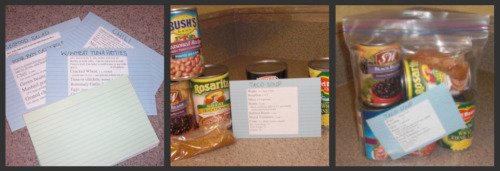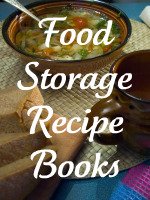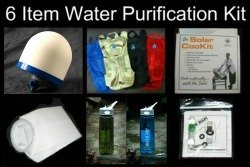|
Meals Ready to Eat3 Month SupplyPut your three month supply of food together with meals ready to eat. This food supply is easy to use in an emergency.

Skip Down To: 6 Steps to a 3-Month supply Benefits of a 3-month Supply?
6 Steps to Building a 3-Month Supply
When I set out to put together my three-month supply of meals ready to eat, it seemed overwhelming. I needed a plan. My friend, Claudia also wanted to put together a plan that broke this project down into steps. Here's what we came up with:
Keep a few meals ready to eat in the pantry and use them on busy hectic days. Keep the recipe cards. When you have a few stacked up, go to the store and replace the ingredients. This is a great way to rotate your three-month supply of food. Start eating your food storage now and save money. Back to Top Recipes & Grocery ListNow the surprise! If you like the recipes Claudia and I have chosen, you can use the ones that are provided here. The recipes and grocery lists are ready to go! There are 3 sets. You can download one or all three of them! 

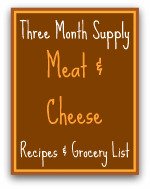
Some of the ingredients in sets 1 & 3 are perishable. You can convert them to non-perishable foods or root cellar foods in case there is no electricity. (ex. powdered cheese, canned or dried meat & vegetables, root cellar potatoes & carrots) We’ve come up with six recipes for each set. To get seven meals for one week, add one of your favorite family recipes. Times the ingredients by 6 and add them to the grocery list. 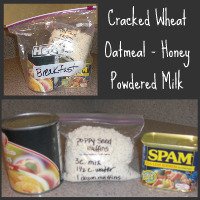
Now, if you want to add in a few breakfast meals, you can. If your family has one good meal a day all ready to go, you‘ll be MILES ahead of everyone else. They’ll all be scrambling around trying to scrape together anything to feed their family. One good meal a day is more than many people around the world get! But a few breakfasts would be a bonus! Peaches, canned ham, muffin mixes, etc. Cracked wheat cereal is a favorite at our house! That would be easy to do-- If you have a wheat grinder? You’re done! Back to Top Return To:Food Storage from Meals Ready to Eat |
Order
Book of Mormon Stories
|
This is the grain mill that I've used for the last 20 years. It works great. I have some other grain mills as a back up, but I haven't used them yet. This one is still going strong. |
|
|
If you're looking for a quality non-electric grain mill, this is a good choice. It easily adjusts from fine to coarse and grinds virtually all dry grains and legumes, including wheat, corn, beans, peas and amaranth.
|
|
The most important part of bulk food storage is getting your food. If you're looking for an inexpensive hand mill. This will work. It will not produce a superfine flour. It works OK for bread. You'll want to have some sort of hand grain mill in case of a power outage.
|
Dehydrated and freeze-dried food can add a lot of variety and nutrition to your basic bulk food storage. Check out the fruits, vegetables, legumes, and meat substitute.
Water is even more important than food. Think ahead. What are you going to do if you can't get clean drinking water?
There are many ways to purify your water. Here are a few different methods:
- You can use a ceramic gravity water filter.
- On a clear day you can pasteurize your water using the sun.
- If you need something lightweight and easy to carry, try our water bottle with filter or you can use our backpacking water filter





